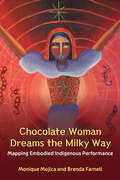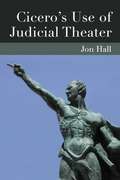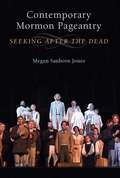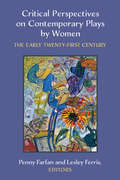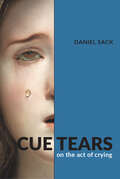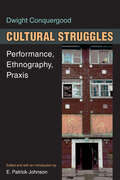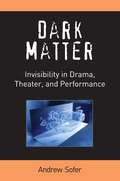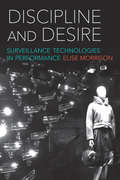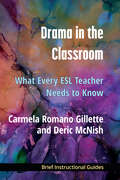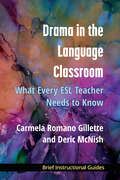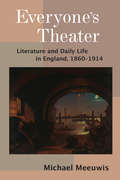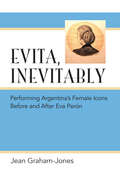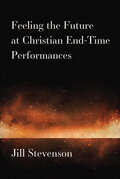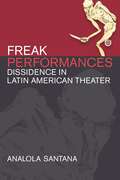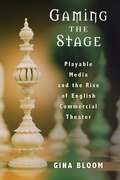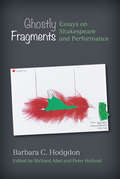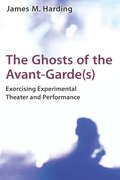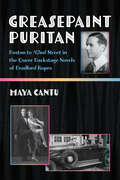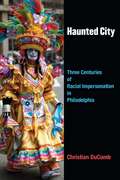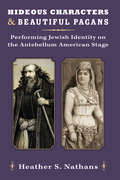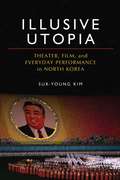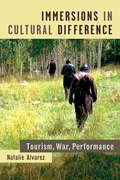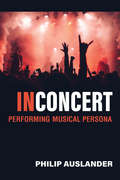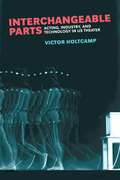- Table View
- List View
Chocolate Woman Dreams the Milky Way: Mapping Embodied Indigenous Performance (Theater: Theory/Text/Performance)
by Brenda Farnell Monique MojicaThis volume documents the creation of Chocolate Woman Dreams the Milky Way, a play written and performed by Monique Mojica with collaborators from diverse disciplines. Inspired by the pictographic writing and mola textiles of the Guna, an indigenous people of Panama and Colombia, the book explores Mojica’s unique approach to the performance process. Her method activates an Indigenous theatrical process that privileges the body in contrast to Western theater’s privileging of the written text, and rethinks the role of land, body, and movement, as well as dramatic story-structure and performance style. Co-authored with anthropologist Brenda Farnell, the book challenges the divide between artist and scholar, and addresses the many levels of cultural, disciplinary, and linguistic translations required to achieve this. Placing the complex intellect inherent to Indigenous Knowledges at its center, the book engages Indigenous performance theory, and concepts that link body, land, and story, such as terra nullius/corpus nullius, mapping, pattern literacy, land literacy, and movement literacy. Enhanced by contributions from other artists and scholars, the book challenges Eurocentric ideologies about what counts as “performance” and what is required from an “audience,” as well as long-standing body-mind dualisms.
Cicero's Use Of Judicial Theater
by Jonathan HallIn Cicero's Use of Judicial Theater, Jon Hall examines Cicero's use of showmanship in the Roman courts, looking in particular at the nonverbal devices that he employs during his speeches as he attempts to manipulate opinion. Cicero's speeches in the law-courts often incorporate theatrical devices including the use of family relatives as props during emotional appeals, exploitation of tears and supplication, and the wearing of specially dirtied attire by defendants during a trial, all of which contrast strikingly with the practices of the modem advocate. Hall investigates how Cicero successfully deployed these techniques and why they played such a prominent part in the Roman courts. These "judicial theatrics" are rarely discussed by the ancient rhetorical handbooks, and Cicero's Use of Judicial Theater argues that their successful use by Roman orators derives largely from the inherent theatricality of aristocratic life in ancient Rome--most of the devices deployed in the courts appear elsewhere in the social and political activities of the elite. While Cicero's Use of Judicial Theater will be of interest primarily to professional scholars and students studying the speeches of Cicero, its wider analyses, both of Roman cultural customs and the idiosyncratic practices of the courts, will prove relevant also to social historians, as well as historians of legal procedure.
Contemporary Mormon Pageantry: Seeking After the Dead
by Megan S JonesIn Contemporary Mormon Pageantry, theater scholar Megan Sanborn Jones looks at Mormon pageants, outdoor theatrical productions that celebrate church theology, reenact church history, and bring to life stories from the Book of Mormon. She examines four annual pageants in the United States-the Hill Cumorah Pageant in upstate New York, the Manti Pageant in Utah, the Nauvoo Pageant in Illinois, and the Mesa Easter Pageant in Arizona. The nature and extravagance of the pageants vary by location, with some live orchestras, dancing, and hundreds of costumed performers, mostly local church members. Based on deep historical research and enhanced by the author's interviews with pageant producers and cast members as well as the author's own experiences as a participant-observer, the book reveals the strategies by which these pageants resurrect the Mormon past on stage. Jones analyzes the place of the productions within the American theatrical landscape and draws connections between the Latter-day Saints theology of the redemption of the dead and Mormon pageantry in the three related sites of sacred space, participation, and spectatorship. Using a combination of religious and performance theory, Jones demonstrates that Mormon pageantry is a rich and complex site of engagement between theater, theology, and praxis that explores the saving power of performance.
Critical Perspectives on Contemporary Plays by Women: The Early Twenty-First Century
by Lesley Ferris Penny FarfanThis book foregrounds some of the ways in which women playwrights from across a range of contexts and working in a variety of forms and styles are illuminating the contemporary world while also contributing to its reshaping as they reflect, rethink, and reimagine it through their work for the stage. The book is framed by a substantial introduction that sets forth the critical vision and structure of the book as a whole, and an afterword that points toward emerging currents in and expansions of the contemporary field of playwriting by women on the cusp of the third decade of the twenty-first century. Within this frame, the twenty-eight chapters that form the main body of the book, each focusing on a single play of critical significance, together constitute a multifaceted, inevitably partial, yet nonetheless integral picture of the work of women playwrights since 2000 as they engage with some of the most pressing issues of our time. Some of these issues include the continuing oppression of and violence against women, people of color, LGBTQ+ people, and ethnic minorities; the ongoing processes of decolonization; the consequences of neoliberal capitalism; the devastation and enduring trauma of war; global migration and the refugee crisis; the turn to right-wing populism; and the impact of climate change, including environmental disaster and species extinction. The book is structured into seven sections: Replaying the Canon; Representing Histories; Staging Lives; Re-imagining Family; Navigating Communities; Articulating Intersections; and New World Order(s). These sections group clusters of plays according to the broad critical actions they perform or, in the case of the final section, the new world orders that they capture through their stagings of the seeming impasse of the politically and environmentally catastrophic global present moment. There are many other points of resonance among and across the plays, but this seven-part structure foregrounds the broader actions that drive the plays, both in the Aristotelian dramaturgical sense and in the larger sense of the critical interventions that the plays creatively enact. In this way, the seven-part structure establishes correspondences across the great diversity of dramatic material represented in the book while at the same time identifying key methods of critical approach and areas of focus that align the book’s contributors across this diversity. The structure of the book thus parallels what the playwrights themselves are doing, but also how the contributors are approaching their work. Plays featured in the book are from Canada, Australia, South Africa, the US, the UK, France, Argentina, New Zealand, Syria, Brazil, Italy, and Austria; the playwrights include Margaret Atwood, Leah Purcell, Yaël Farber, Paula Vogel, Adrienne Kennedy, Suzan-Lori Parks, debbie tucker green, Lisa Loomer, Hélène Cixous, Anna Deavere Smith, Lola Arias, Lisa Kron and Jeanine Tesori, Marie Clements, Quiara Alegría Hudes, Alia Bano, Holly Hughes, Whiti Hereaka, Julia Cho, Liwaa Yazji, Grace Passô, Dominique Morisseau, Emma Dante, Frances Ya-Chu Cowhig, Lynn Nottage, Elfriede Jelinek, Caryl Churchill, Colleen Murphy, and Lucy Kirkwood. Encompassing several generations of playwrights and scholars, ranging from the most senior to mid-career to emerging voices, the book will be essential reading for established researchers, a valuable learning resource for students at all levels, and a useful and accessible guide for theater practitioners and interested theater-goers.
Cue Tears: On the Act of Crying
by Daniel SackCrying holds a privileged place in conversations around emotions as an expression of authentic feeling. And yet, tears are ambiguous: they might signal the most positive and negative of affects; they might present a sincere revelation of self or be simulated to manipulate others. Unsurprisingly, tears figure prominently on stage and on screen, where actors have experimented with the mechanics of making tears. Cue Tears: On the Act of Crying uses tears as a prism through which to see some of the foundational problems and paradoxes of acting and spectatorship anew, including matters of authenticity and sincerity, the ethics of the witness, the interaction between a speech act and its affective force, liveness and documentation. Across seven semi-autonomous essays, Cue Tears looks at the mechanisms of tear production, internal and external techniques that actors use to weep, and the effects of tears in performance situations on the stage, in the gallery, and in the classroom. The writing moves with a light touch between theory and criticism of a broad range of instances from literature, theater, performance art, visual art, and cinema, while also embracing a strong autobiographical and personal slant. Author Daniel Sack’s father was a biochemist who studied tears and collected his son’s tears for research during his childhood. These “reflex tears” were produced as a physical response to irritation—an eye stretched past the point of blinking, a cotton swab up the nose. This childhood occupation coincided with his first years taking acting classes, trying to learn how to cry “emotional tears” onstage through psychological stimulation and the recollection of memory. Cue Tears investigates these memories and methods, finding that tears both shore up and dissolve distinctions between truth and artifice, emotional and physical, private and public, sad and humorous.
Cultural Struggles: Performance, Ethnography, Praxis
by E. Patrick Johnson Dwight ConquergoodThe late Dwight Conquergood's research has inspired an entire generation of scholars invested in performance as a meaningful paradigm to understand human interaction, especially between structures of power and the disenfranchised. Conquergood's research laid the groundwork for others to engage issues of ethics in ethnographic research, performance as a meaningful paradigm for ethnography, and case studies that demonstrated the dissolution of theory/practice binaries.Cultural Struggles is the first gathering of Conquergood's work in a single volume, tracing the evolution of one scholar's thinking across a career of scholarship, teaching, and activism, and also the first collection of its kind to bring together theory, method, and complete case studies. The collection begins with an illuminating introduction by E. Patrick Johnson and ends with commentary by other scholars (Micaela di Leonardo, Judith Hamera, Shannon Jackson, D. Soyini Madison, Lisa Merrill, Della Pollock, and Joseph Roach), engaging aspects of Conquergood's work and providing insight into how that work has withstood the test of time, as scholars still draw on his research to inform their current interests and methods.
Dark Matter: Invisibility In Drama, Theater, And Performance
by Andrew SoferDark Matter maps the invisible dimension of theater whose effects are felt everywhere in performance. Examining phenomena such as hallucination, offstage character, offstage action, sexuality, masking, technology, and trauma, Andrew Sofer engagingly illuminates the invisible in different periods of postclassical western theater and drama. He reveals how the invisible continually structures and focuses an audience’s theatrical experience, whether it’s black magic in Doctor Faustus, offstage sex in A Midsummer Night’s Dream, masked women in The Rover, self-consuming bodies in Suddenly Last Summer, or surveillance technology in The Archbishop’s Ceiling. Each discussion pinpoints new and striking facets of drama and performance that escape sight. Taken together, Sofer’s lively case studies illuminate how dark matter is woven into the very fabric of theatrical representation. Written in an accessible style and grounded in theater studies but interdisciplinary by design, Dark Matter will appeal to theater and performance scholars, literary critics, students, and theater practitioners, particularly playwrights and directors.
Discipline and Desire: Surveillance Technologies in Performance
by Elise MorrisonDiscipline and Desire examines how surveillance technologies, when placed within the frames of theater and performance, can be used to critique and reimagine the politics of surveillance in everyday life. The book explores how rapidly proliferating surveillance technologies, including drones, CCTV cameras, GPS tracking systems, medical surveillance equipment, and facial recognition software, can be repurposed through performance to become technologies of ethical witnessing, critique, and action. While the subject of surveillance continues to provoke fascination and debate in mainstream media and academia, opportunities to critically reflect upon and, more importantly, to imagine alternative, creative responses to living in a rapidly expanding surveillance society have been harder to find. Author Elise Morrison argues that such opportunities are being created through the growing genre of "surveillance art and performance," defined as works that centrally employ technologies and techniques of surveillance to create theater, installation, and performance art. Introducing readers to a broad range of surveillance art works, including the work of artists and activists such as Surveillance Camera Players, Jill Magid, Steve Mann, Hasan Elahi, Wafaa Bilal, Blast Theory, Electronic Disturbance Theater, George Brant, Janet Cardiff, Mona Hatoum, and Zach Blas, Discipline and Desire provides a practical and analytical framework that can aid the diverse pursuits of new media-arts practitioners, performance scholars, activists, and hobbyists interested in critical and creative uses of surveillance technologies.
Drama in the Language Classroom: What Every ESL Teacher Needs to Know
by Carmela Romano Gillette Deric McNish"Our particular approach is built on the belief that using elements of drama and the performing arts in the language classroom works best when it builds on concepts of language development that have been tested and supported. As language scholars, we know that honoring students’ identities is important; that investment in the learning process must be nurtured; that learners respond to material that is engaging, relevant, and authentic; that learners must use the language and not just study it; and that affective factors can sometimes impede learning." ---Carmela Romano Gillette & Deric McNish This e-book weaves together cutting-edge research and practices from the fields of theater and TESOL. After providing an overview of how drama can be used in the language classroom, Gillette (a TESOL expert) and McNish (an expert in actor training) present a collection of resources teachers need to begin using drama, including practical classroom-tested and evidence-based techniques. They show how: * theater games can build confidence. * performing (beyond role-plays) can develop a deeper context for speaking. * improvisation can create authentic opportunities for language use. * para- and extra-linguistic techniques can improve expression and meaningful communication. * activities like script analysis can be used in reading and writing classes (and to examine differences between spoken and written language). * drama-based activities can provide a platform for examining cultural norms and practices. Each section includes sample activities for improving fluency and assessment suggestions. ?No experience with performance or drama required to learn how to incorporate these practices into your ESL classroom!
Drama in the Language Classroom: What Every ESL Teacher Needs to Know
by Deric McNish Carmela Romano GilletteDrama in the Language Classroom weaves together cutting-edge research and practices from the fields of theater and TESOL. After providing an overview of how drama can be used in the language classroom, Carmela Romano Gillette (a TESOL expert) and Deric McNish (an expert in actor training) present a collection of resources teachers need to begin using drama, including practical classroom-tested and evidence-based techniques. They show how theater, performance, and improvisation can help students build confidence, develop a deeper context for speaking, and create authentic opportunities for language use. In addition, they outline the para- and extra-linguistic techniques that can improve expression and meaningful communication. Each section includes sample activities, such as script analysis for improving fluency, and assessment suggestions. Readers do not need to have experience with performance or drama to learn how to incorporate these practices into the ESL classroom.
Everyone’s Theater: Literature and Daily Life in England, 1860–1914
by Michael MeeuwisNearly all residents of England and its colonies between 1860 and 1914 were active theatergoers, and many participated in the amateur theatricals that defined late Victorian life. The Victorian theater was not an abstract figuration of the world as a stage, but a media system enmeshed in mass lived experience that fulfilled in actuality the concept of a theatergoing nation. Everyone’s Theater turns to local history, the words of everyday Victorians found in their diaries and production records, to recover this lost chapter of theater history in which amateur drama domesticates the stage. Professional actors and playwrights struggled to make their productions compatible with ideas and techniques that could be safely reproduced in the home—and in amateur performances from Canada to India. This became the first true English national theater: a society whose myriad classes found common ground in theatrical display. Everyone’s Theater provides new ways to extend Victorian literature into the dimension of voice, sound, and embodiment, and to appreciate the pleasures of Victorian theatricality.
Evita, Inevitably: Performing Argentina's Female Icons Before and After Eva Perón
by Jean Graham-JonesEvita, Inevitably sheds new light on the history and culture of Argentina by examining the performances and reception of the country's most iconic female figures, in particular, Eva Perón, who rose from poverty to become a powerful international figure. The book links the Evita legend to a broader pattern of female iconicity from the mid-nineteenth century onward, reading Evita against the performances of other female icons: Camila O'Gorman, executed by firing squad over her affair with a Jesuit priest; Difunta Correa, a devotional figure who has achieved near-sainthood; cumbia-pop performer Gilda; the country's patron saint, the Virgin of Luján; and finally, Argentina's president, Cristina Fernández de Kirchner. Employing the tools of discursive, visual, and performance analysis, Jean Graham-Jones studies theatrical performance, literature, film, folklore, Catholic iconography, and Internet culture to document the ways in which these "femicons" have been staged.
Feeling the Future at Christian End-Time Performances
by Jill C StevensonThe End is always near. The Apocalypse has sparked imaginations for millennia, while in more recent times, highly publicized predictions have thrust End-Time theology briefly into the spotlight. In the 21st century, fictional depictions of various apocalyptic scenarios are found in an endless stream of films, TV shows, and novels, while real-world media coverage of global issues including climate change and the migrant crisis often features an apocalyptic tone. Feeling the Future at Christian End-Time Performances explores this prevalent human desire to envision the End by analyzing how various live End-Time performances allow people to live in and through future time. ? The book’s main focus is contemporary Christian End-Time performances and how they theatrically construct encounters with future time—not just images or ideas of a future, but viscerally and immediately real experiences of future time. Author Jill Stevenson’s examples are Hell Houses and Judgement Houses; Rapture House, a similarly styled “walk through drama” in North Carolina; Hell’s Gates, an “outdoor reality drama” in Dawsonville, Georgia; Ark Encounter, a full-size recreation of Noah’s Ark; and Tribulation Trail, an immersive thirteen-scene drama ministry based on the Book of Revelation. The book’s coda considers similarities between these Christian performances and secular survivalist prepper events, especially with respect to constructions of and language about time. In doing so, the author situates these performances within a larger tradition that challenges traditional secular/sacred distinctions and illuminates how the End Times has been employed in our current social and political moment.
Feeling the Future at Christian End-Time Performances
by Jill C. StevensonThe End is always near. The Apocalypse has sparked imaginations for millennia, while in more recent times, highly publicized predictions have thrust End-Time theology briefly into the spotlight. In the 21st century, fictional depictions of various apocalyptic scenarios are found in an endless stream of films, TV shows, and novels, while real-world media coverage of global issues including climate change and the migrant crisis often features an apocalyptic tone. Feeling the Future at Christian End-Time Performances explores this prevalent human desire to envision the End by analyzing how various live End-Time performances allow people to live in and through future time. The book’s main focus is contemporary Christian End-Time performances and how they theatrically construct encounters with future time—not just images or ideas of a future, but viscerally and immediately real experiences of future time. Author Jill Stevenson’s examples are Hell Houses and Judgement Houses; Rapture House, a similarly styled “walk through drama” in North Carolina; Hell’s Gates, an “outdoor reality drama” in Dawsonville, Georgia; Ark Encounter, a full-size recreation of Noah’s Ark; and Tribulation Trail, an immersive thirteen-scene drama ministry based on the Book of Revelation. The book’s coda considers similarities between these Christian performances and secular survivalist prepper events, especially with respect to constructions of and language about time. In doing so, the author situates these performances within a larger tradition that challenges traditional secular/sacred distinctions and illuminates how the End Times has been employed in our current social and political moment.
Freak Performances: Dissidence in Latin American Theater
by Analola SantanaThe figure of the freak as perceived by the Western gaze has always been a part of the Latin American imaginary, from the letters that Columbus wrote about his encounters with dog-faced people to Shakespeare's Caliban. The freak acquires greater significance in a globalized, neoliberal world that defines the "abnormal" as one who does not conform mentally, physically, or emotionally and is unable or unwilling to follow the economic and cultural norms of the institutions in power. Freak Performances examines the continuing effects of colonialism on modern Latin American identities, with a particular focus on the way it has constructed the body of the other through performance. Theater questions the representations of these bodies, as it enables the empowerment of the silenced other; the freak as a spectacle of otherness finds in performance an opportunity for re-appropriation by artists resisting the dominant authority. Through an analysis of experimental theater, dance theater, performance art, and gallery-based installation art across eight countries, Analola Santana explores the theoretical issues shaped by the encounters and negotiations between different bodies in the current Latin American landscape.
Gaming the Stage: Playable Media and the Rise of English Commercial Theater (Theater: Theory/Text/Performance)
by Gina BloomRich connections between gaming and theater stretch back to the 16th and 17th centuries, when England's first commercial theaters appeared right next door to gaming houses and blood-sport arenas. In the first book-length exploration of gaming in the early modern period, Gina Bloom shows that theaters succeeded in London's new entertainment marketplace largely because watching a play and playing a game were similar experiences. Audiences did not just see a play; they were encouraged to play the play, and knowledge of gaming helped them become better theatergoers. Examining dramas written for these theaters alongside evidence of analog games popular then and today, Bloom argues for games as theatrical media and theater as an interactive gaming technology. Gaming the Stage also introduces a new archive for game studies: scenes of onstage gaming, which appear at climactic moments in dramatic literature. Bloom reveals plays to be systems of information for theater spectators: games of withholding, divulging, speculating, and wagering on knowledge. Her book breaks new ground through examinations of plays such as The Tempest, Arden of Faversham, A Woman Killed with Kindness, and A Game at Chess; the histories of familiar games such as cards, backgammon, and chess; less familiar ones, like Game of the Goose; and even a mixed-reality theater videogame.
Ghostly Fragments: Essays on Shakespeare and Performance
by Barbara C. HodgdonGhostly Fragments gathers the essays of the late Barbara C. Hodgdon, a renowned scholar of Shakespeare and performance studies. Her influential publications over thirty years reflected a remarkable intelligence, wit, and originality, as did her lectures and conference papers. Richard Abel and Peter Holland have selected essays that represent the wide sweep of Hodgdon’s scholarship, including unpublished pieces and those from hard-to-access sources. The essays reveal a thinker and writer who grows more self-reflective over time, with a distinctive, engaging, often wryly humorous voice that is accessible even to nonspecialist readers. Following a general introduction by Peter Holland, the book’s five subsections (Teaching Shakespeare, Analyzing Stage Performances, Editing Shakespeare Texts, Analyzing Shakespeare Films, and “Shopping” in the Archives) are introduced in turn by scholars Miriam Gilbert, W.B. Worthen, Margaret Jane Kidnie, Richard Abel, and Pascale Aebischer. Collectively, the pieces confirm the originality and élan of Hodgdon’s thinking and writing over time, and reveal her as a natural essayist and stylist, with a distinctive engaging voice. The collection is unique in not only bringing together so much of Hodgdon's work in one place (with an extensive bibliography of her published work) but also in demonstrating how groundbreaking and influential that work has been in the field.
Ghosts Of The Avant-garde(s): Exorcising Experimental Theater And Performance
by James M. HardingThe Ghosts of the Avant-Garde(s) offers a strikingly new perspective on key controversies and debates within avant-garde studies, arguing for the importance of reopening pivotal controversies and debates in avant-garde studies and challenging pronouncements of the "death of the avant-garde" that tend to obscure the diversity and plurality of avant-garde gesture and expression. James M. Harding revisits iconic sites of early 20th-century performance to examine how European avant-gardists attempted--unsuccessfully--to employ that discourse as a strategy for enforcing uniformity among a politically and culturally diverse group of artists. He then takes aim at historical and aesthetic categories that have promoted a restrictive history and theory of the avant-garde and narrow readings of avant-garde performance. Harding reveals the Eurocentric undercurrents that underlie these categories and urges a consideration of the global political dimensions of avant-garde gestures. His book will interest scholars of theater and performance, art history, and literary studies, as well as those interested in the relation of art to politics in various historical periods and cultures.
Greasepaint Puritan: Boston to 42nd Street in the Queer Backstage Novels of Bradford Ropes
by Maya CantuGreasepaint Puritan details the life and work of Bradford Ropes, author of the bawdy 1932 novel 42nd Street, on which the classic film and its stage adaptation are based. Inspired by Ropes’s own experiences as a performer, 42nd Street “reads less like a novel than like a documentary about the lives of New York’s theatre people and, above all, about the practicalities, the personalities, and the sexual politics that go into the making of a show,” according to Richard Brody in The New Yorker. Why did Ropes’s body of work--which included a trilogy of backstage novels--and consequently his biographical footsteps, disappear into obscurity? Descended from Mayflower Pilgrims, Ropes rebelled against the “Proper Bostonian” life, in a career that touched upon the Jazz Age, American vaudeville, and theater censorship. Greasepaint Puritan follows Ropes’s successful career as both a performer and the author of the backstage novels 42nd Street, Stage Mother, and Go Into Your Dance. Populated by scheming stage mothers, precocious stage children, grandiose bit players, and tart-tongued chorines, these novels centered on the lives and relationships of gay men on Broadway during the Jazz Age and Prohibition era. Rigorously researched, Greasepaint Puritan chronicles Ropes’s career as a successful screenwriter in 1930s and ’40s Hollywood, where he continued to be a part of a dynamic gay subculture within the movie industry before returning to obscurity in the 1950s. His legacy lives on in the Hollywood and Broadway incarnations of 42nd Street—but Greasepaint Puritan restores the “forgotten melody” of the man who first envisioned its colorful characters.
Haunted City: Three Centuries of Racial Impersonation in Philadelphia
by Christian DucombHaunted City explores the history of racial impersonation in Philadelphia from the late eighteenth century through the present day. The book focuses on select historical moments, such as the advent of the minstrel show and the ban on blackface makeup in the Philadelphia Mummers Parade, when local performances of racial impersonation inflected regional, national, transnational, and global formations of race. Mummers have long worn blackface makeup during winter holiday celebrations in Europe and North America; in Philadelphia, mummers’ blackface persisted from the colonial period well into the twentieth century. The first annual Mummers Parade, a publicly sanctioned procession from the working-class neighborhoods of South Philadelphia to the city center, occurred in 1901. Despite a ban on blackface in the Mummers Parade after civil rights protests in 1963–64, other forms of racial and ethnic impersonation in the parade have continued to flourish unchecked. Haunted City combines detailed historical research with the author’s own experiences performing in the Mummers Parade to create a lively and richly illustrated narrative. Through its interdisciplinary approach, Haunted City addresses not only theater history and performance studies but also folklore, American studies, critical race theory, and art history. It also offers a fresh take on the historiography of the antebellum minstrel show.
Hideous Characters and Beautiful Pagans: Performing Jewish Identity on the Antebellum American Stage
by Heather NathansWhile battling negative stereotypes, American Jews carved out new roles for themselves within the first theatrical entertainments in America. Jewish citizens were active as performers, playwrights, critics, managers, and theatrical shareholders, and often tied their involvement in these endeavors to the patriotic rhetoric of the young republic as they struggled to establish themselves in the new nation. Examining play texts, theatrical reviews, political discourse, and public performances of Jewish rights and rituals, Hideous Characters and Beautiful Pagans argues that Jewish stage types shed light on our understanding of the status of Jewish Americans during a critical historical period. Using an eclectic range of sources including theatrical reviews, diaries, letters, cartoons, portraiture, tax records, rumors flying around the tavern, and more, Heather S. Nathans has listened for the echoes of vanished audiences who witnessed and responded to these stereotypes onstage, from the earliest appearance of Shylock on an American stage in 1752 to Jewish theater artists on the eve of the Civil War. The book integrates social, political, and cultural histories, with an examination of those texts (both dramatic and literary) that shaped the stage Jew.
Illusive Utopia
by Suk-Young KimNo nation stages massive parades and collective performances on the scale of North Korea. Even amid a series of intense political/economic crises and international conflicts, the financially troubled country continues to invest massive amounts of resources to sponsor unflinching displays of patriotism, glorifying its leaders and revolutionary history through state rituals that can involve hundreds of thousands of performers. Author Suk-Young Kim explores how sixty years of state-sponsored propaganda performances---including public spectacles, theater, film, and other visual media such as posters---shape everyday practice such as education, the mobilization of labor, the gendering of social interactions, the organization of national space, tourism, and transnational human rights. Equal parts fascinating and disturbing, Illusive Utopia shows how the country's visual culture and performing arts set the course for the illusionary formation of a distinctive national identity and state legitimacy, illuminating deep-rooted cultural explanations as to why socialism has survived in North Korea despite the fall of the Berlin Wall, the collapse of the Soviet Union, and China's continuing march toward economic prosperity. With over fifty striking color illustrations, Illusive Utopia captures the spectacular illusion within a country where the arts are not only a means of entertainment but also a forceful institution used to regulate, educate, and mobilize the population.
Immersions in Cultural Difference: Tourism, War, Performance
by Natalie AlvarezIn a time of intensifying xenophobia and anti-immigration measures, this book examines the impulse to acquire a deeper understanding of cultural others. Immersions in Cultural Difference takes readers into the heart of immersive simulations, including a simulated terrorist training camp in Utah; mock Afghan villages at military bases in Canada and the UK; a fictional Mexico-US border run in Hidalgo, Mexico; and an immersive tour for settlers at a First Nations reserve in Manitoba, Canada. Natalie Alvarez positions the phenomenon of immersive simulations within intersecting cultural formations: a neoliberal capitalist interest in the so-called “experience economy” that operates alongside histories of colonization and a heightened state of xenophobia produced by War on Terror discourse. The author queries the ethical stakes of these encounters, including her own in relation to the field research she undertakes. As the book moves from site to site, the reader discovers how these immersions function as intercultural rehearsal theaters that serve a diverse set of strategies and pedagogical purposes: they become a “force multiplier” within military strategy, a transgressive form of dark tourism, an activist strategy, and a global, profit-generating practice for a neoliberal capitalist marketplace.
In Concert: Performing Musical Persona
by Philip AuslanderThe conventional way of understanding what musicians do as performers is to treat them as producers of sound; some even argue that it is unnecessary to see musicians in performance as long as one can hear them. But musical performance, counters Philip Auslander, is also a social interaction between musicians and their audiences, appealing as much to the eye as to the ear. In Concert: Performing Musical Persona he addresses not only the visual means by which musicians engage their audiences through costume and physical gesture, but also spectacular aspects of performance such as light shows. Although musicians do not usually enact fictional characters on stage, they nevertheless present themselves to audiences in ways specific to the performance situation. Auslander’s term to denote the musician’s presence before the audience is musical persona. While presence of a musical persona may be most obvious within rock and pop music, the book’s analysis extends to classical music, jazz, blues, country, electronic music, laptop performance, and music made with experimental digital interfaces. The eclectic group of performers discussed include the Beatles, Miles Davis, Keith Urban, Lady Gaga, Nicki Minaj, Frank Zappa, B. B. King, Jefferson Airplane, Virgil Fox, Keith Jarrett, Glenn Gould, and Laurie Anderson.
Interchangeable Parts: Acting, Industry, and Technology in US Theater (Theater: Theory/Text/Performance)
by Victor HoltcampWhile Hollywood has long been called “The Dream Factory,” and theatrical entertainment more broadly has been called “The Industry,” the significance of these names has rarely been explored. There are in fact striking overlaps between industrial rhetoric and practice and the development of theatrical and cinematic techniques for rehearsal and performance. Interchangeable Parts examines the history of acting pedagogy and performance practice in the United States, and their debts to industrial organization and philosophy. Ranging from the late nineteenth century through the end of the twentieth, the book recontextualizes the history of theatrical technique in light of the embrace of industrialization in US culture and society. Victor Holtcamp explores the invocations of scientific and industrial rhetoric and philosophy in the founding of the first schools of acting, and echoes of that rhetoric in playwriting, production, and the cinema, as Hollywood in particular embraced this industrially infected model of acting. In their divergent approaches to performance, the major US acting teachers (Lee Strasberg, Stella Adler, and Sanford Meisner) demonstrated strong rhetorical affinities for the language of industry, illustrating the pervasive presence of these industrial roots. The book narrates the story of how actors learned to learn to act, and what that process, for both stage and screen, owed to the interchangeable parts and mass production revolutions.
